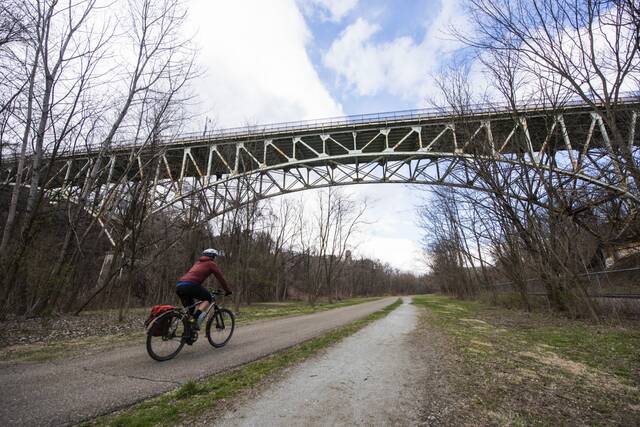Pittsburgh officials closing Charles Anderson Memorial Bridge because of safety concerns
Pittsburgh officials closed the city’s Charles Anderson Memorial Bridge to vehicular traffic Wednesday afternoon because of safety concerns.
“I made a pledge to the residents of Pittsburgh that I will not hesitate to close a bridge for the safety of our citizens,” Mayor Ed Gainey said. “Inspection results have come back that tell us this bridge needs repair work to be safe for traffic.”
The bridge, located in Schenley Park, will remain open to pedestrians and bicyclists. The Junction Hollow Trail, which is below the bridge, also will remain open.
The 780-foot-long bridge opened in 1938 and is used by an average of more than 21,000 vehicles a day. PennDOT records list the bridge as being in poor condition and show it was weight-restricted, with a 32-ton limit for single vehicles and a combined weight limit on the bridge of 40 tons.
The span had raised concerns among some residents who traveled across it, especially after another bridge in the city’s Frick Park collapsed last January.
In the wake of the Fern Hollow Bridge collapse, Gainey launched a bridge asset management program designed to ensure that the 147 city-owned bridges were properly maintained. He also commissioned a comprehensive bridge report, which showed dozens of spans needed repairs.
“It’s because of the safety systems that we have put in place over the last year that we can act immediately, and proactively, to close this bridge — preventing another Fern Hollow,” the mayor said.
Related
• Deterioration under Pittsburgh's Charles Anderson Bridge raises concerns; city says bridge already in rehab process
• A year after Fern Hollow Bridge collapse, are Western Pa.'s bridges in better shape?
• Forever changed: Group of Pittsburgh strangers detail how their lives changed after Fern Hollow Bridge collapse
Officials were in the process of closing the span just after 2 p.m., with crews stopping traffic and setting up detour signs, according to Maria Montaño, a spokeswoman for the mayor.
Montaño said officials thought it was safe to allow cyclists and pedestrians to continue using the bridge and the trail underneath it.
“We didn’t feel like the bridge was in immediate danger of falling down,” she said. “Closing it to vehicular traffic is a step we thought was best to be preemptive while we do the necessary repairs. At this point, we didn’t feel it was a danger to pedestrians or cyclists.”
Necessary repairs to the Charles Anderson Memorial Bridge will be undertaken “as soon as possible” to allow the bridge to reopen to vehicle traffic, officials said.
The city Department of Mobility & Infrastructure estimated the repairs will take at least four months and will cost between $1 million and $2 million.
During the closure, officials said eastbound or outbound vehicles should instead take the Boulevard of the Allies, turn right onto Bates Street, left onto Second Avenue, left onto Greenfield Avenue, left onto Ronald Street, right onto Alger Street and left onto Greenfield Bridge to Greenfield Road and then to Panther Hollow Road.
Drivers traveling westbound or inbound can take Panther Hollow Road to Greenfield Road to Greenfield Bridge and turn right onto Alger Street, left onto Winterburn Street, right onto Greenfield Avenue, right onto Second Avenue and right onto Bates Street.
When the comprehensive bridge report inspection was conducted at the Charles Anderson Memorial Bridge, inspections did not indicate a need to close the span, officials said. The results of an updated structural analysis, however, led officials to determine the bridge should be closed until it can be repaired.
The bridge report, which city officials released in December, ranked the span as being in poor condition. It classified the superstructure and substructure as being in poor condition, but ranked the deck in fair condition.
A 2018 inspection also ranked the span as poor, and listed the deck, superstructure and substructure all as being in poor condition, with each receiving a rating of 4. Bridges are rated on a scale of 0 to 9, with ratings of 4 or less considered poor.
In the 2018 inspection, officials appraised the structure as being “basically intolerable, requiring high-priority corrective action.”
The bridge, which links Squirrel Hill and Greenfield to Oakland and Downtown, was already slated for a $48 million rehabilitation. Design work for that project is underway, officials said.
Julia Felton is a TribLive reporter covering Pittsburgh City Hall and other news in and around Pittsburgh. A La Roche University graduate, she joined the Trib in 2020. She can be reached at jfelton@triblive.com.
Remove the ads from your TribLIVE reading experience but still support the journalists who create the content with TribLIVE Ad-Free.

